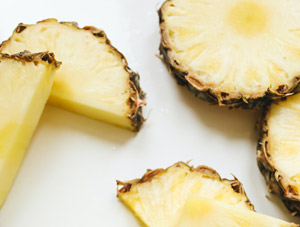About Pineapple
- Pineapple is a member of the Bromeliaceae botanical family.
- Native to South America, pineapple grows as a small shrub in tropical and subtropical climates.
Purchasing, Storing and Preparing
- Pineapples are available year round in the grocery store, though their peak growing season is from March to July.
- Pineapples are typically picked at their prime ripeness. They don't ripen or become sweeter after they are picked.
- Choose pineapples that feel heavy for their size and have a sweet fruity smell. The leaves should be dark green. Avoid pineapple with soft spots, dark spots and those with dry looking leaves.
- To prepare, slice off the top and bottom of the pineapple. Stand the pineapple up and cut off the outer skin in strips until all skin is removed. Cut around the middle core and remove the core. Chop or dice as desired.
- Use pineapple fresh, frozen or canned. Choose canned pineapple in 100% juice and avoid pineapple in syrup to reduce your added sugar intake.
- Add pineapple to salads, salsas or try grilling pineapple. Eat plain as a delicious sweet treat.
Nutrition Information
- Pineapple is an excellent source of vitamin C and manganese.
- Vitamin C aids in the absorption of iron while also playing a big role in wound healing.
- Manganese is essential for normal brain and nerve function. Manganese also helps the body to form connective tissue, bones, and sex hormones.
- Pineapples are naturally fat free, cholesterol free and low in sodium.
Nutrition Facts
1 cup diced
Calories: 80 | Protein: 1.0 g | Fat: 0.0 g | Carbohydrate: 18 g | Fiber: 2.0 g | Calcium: 19.6 mg | Iron: 0.4 mg | Magnesium: 19.8 mg | Phosphorus: 13.2 mg | Folate: 29.7 µg | Vitamin A: 99.4 IU
 Recipes
Recipes
Request an Appointment
